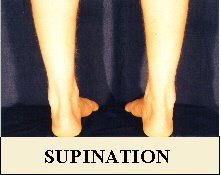I commented that when I lift my pelvis away from the ground, I'm extending the hip. The gluteus maximus muscle plays an important role in creating hip extension. That's why it started to burn after several minutes in the pose.
 The gluteus maximus also externally rotates the thigh.
The gluteus maximus also externally rotates the thigh.So when I really work to lift mypelvis high, or for a long time, the glutes tend to kick in and do their other job. My thighs roll out, knees come apart and more weight shifts to the outside edges of my feet.
That's called supination when the feet are imbalanced so that the arch is high and there's more weight on the outer edges of the feet than the inner.
One of my readers from Maryland, Lynn, wrote me this email yesterday, after she read my Daily Yoga Tip:
Hi Kevin,Would it make any sense to place a belt around one's legs, below the knees, in order to keep them from separating, while doing setu bandhasana?Hope you are doing well.Namaste, Lynn
Here's my reply:
Don't just read about it. Get up. Experience it. Experience yoga!
Kevin Perry
www.ExperienceYoga.org
p.s., The Sanskrit word of the day from my last Daily Yoga Tip was bandha. Bandha means to bind or tie together, as in setu bandha sarvanasana, the bridge pose. By the way, setu means bridge. Sarvanga means all of the limbs or body parts. So this pose name in Sanskrit literally means to construct or tie together a bridge made with all of the body parts pose.
p.p.s., Today's Sanskrit word of the day is pada. I'll tell you what it means next time.
p.p.p.s, We still have openings in the Experience Sanskrit workshop in Downers Grove, IL on Saturday, April 8. If you've been intending to sign up, but haven't done it yet, please do it today. I don't want you to miss the workshop because it fills up to capacity. You can register here.
We're also doing the Experience Neti Flow workshop at Masterpeace Studios in Kirkwood, MO (St. Louis) on May 6 at 3:00 pm. Tuition is $30. You can register here. The Experience Sanskrit workshop is earlier that same day.
p.p.p.p.s., We're planning to announce our Experience Mudra workshop tomorrow. We've got a tentative date in St. Louis for May. Check back tomorrow for details. Reading about the power and effects of hasta mudra is not the same as actually doing the hand gestures and feeling the effects for yourself.
Copyright 2006.
All rights reserved, Mo Yoga LLC.
Kevin Perry
Mo Yoga LLC
1305 Elmerine Ave
Jefferson City, MO 65101
(573) 680-6737
It does make sense, but for a particular purpose and limited time.Thanks, Lynn for this great question.
I like to use a belt simply to help get a feel for doing the pose without the knees apart and feet supinated. This is such a strong body pattern, I find it useful for students simply to see what it's like to do the pose with thighs parallel and feet balanced. Belting the legs helps provide that experience without too much trouble.
If you use a belt, I recommend that you put it around your thighs, above your knees. I suggest this because you'll notice that when you belt your legs while doing a pose, you tend to push them out against the resistance of the belt. I want the upper thighs to press out, away from the mid-line of my body. This broadens the back of my pelvis and creates room for the tailbone to tuck.
When I belt my shins, I have a tendency to push the shins apart, which I'm already good at, hence, supination.
Ultimately, you benefit most by learning to keep your thighs parallel on your own, without a strap, using skillful action. You want to develop the skill of using the gluteus maximus to extend the hip without using it to rotate the thighs outward.
One way to get a feel for this is to practice coming into and out of bridge pose holding a foam block between your knees or shins. If you drop the block you'll know you've let your knees come apart. That tells you you're using your glutes not just for hip extension, but for external thigh rotation as well.
Don't just read about it. Get up. Experience it. Experience yoga!
Kevin Perry
www.ExperienceYoga.org
p.s., The Sanskrit word of the day from my last Daily Yoga Tip was bandha. Bandha means to bind or tie together, as in setu bandha sarvanasana, the bridge pose. By the way, setu means bridge. Sarvanga means all of the limbs or body parts. So this pose name in Sanskrit literally means to construct or tie together a bridge made with all of the body parts pose.
p.p.s., Today's Sanskrit word of the day is pada. I'll tell you what it means next time.
p.p.p.s, We still have openings in the Experience Sanskrit workshop in Downers Grove, IL on Saturday, April 8. If you've been intending to sign up, but haven't done it yet, please do it today. I don't want you to miss the workshop because it fills up to capacity. You can register here.
We're also doing the Experience Neti Flow workshop at Masterpeace Studios in Kirkwood, MO (St. Louis) on May 6 at 3:00 pm. Tuition is $30. You can register here. The Experience Sanskrit workshop is earlier that same day.
p.p.p.p.s., We're planning to announce our Experience Mudra workshop tomorrow. We've got a tentative date in St. Louis for May. Check back tomorrow for details. Reading about the power and effects of hasta mudra is not the same as actually doing the hand gestures and feeling the effects for yourself.
Copyright 2006.
All rights reserved, Mo Yoga LLC.
Kevin Perry
Mo Yoga LLC
1305 Elmerine Ave
Jefferson City, MO 65101
(573) 680-6737






No comments:
Post a Comment